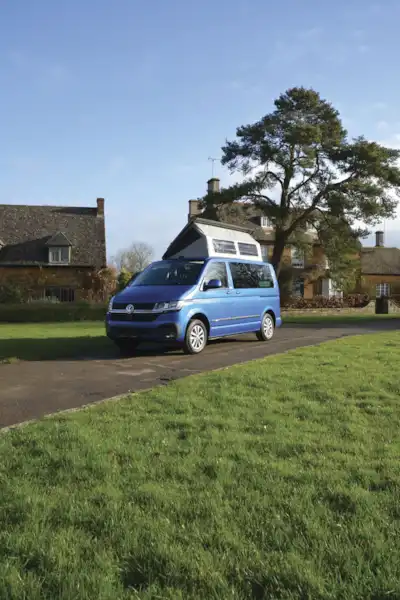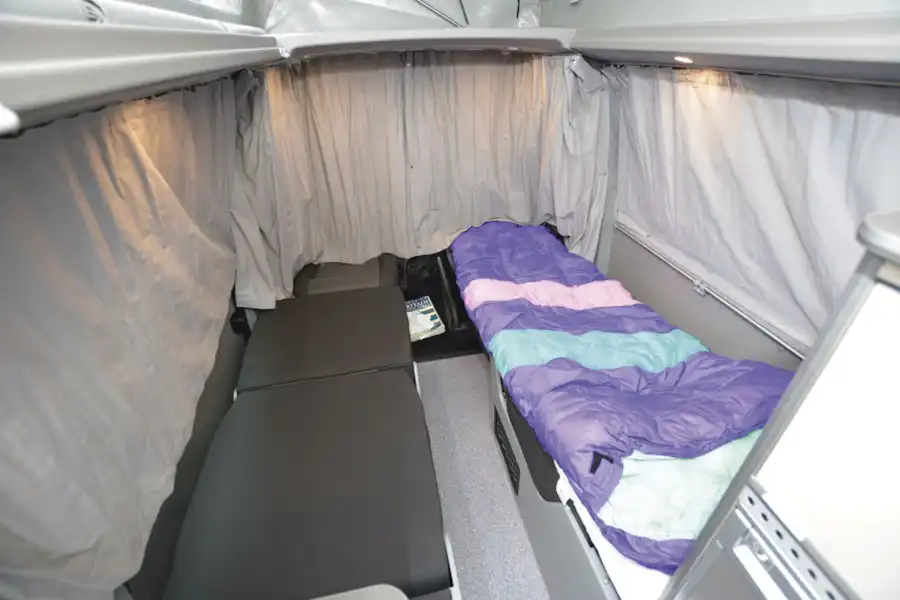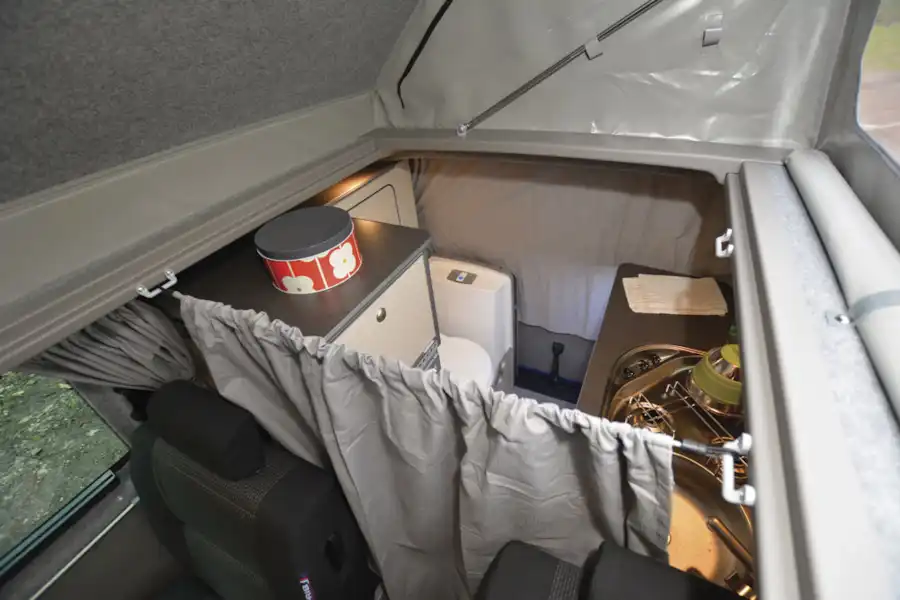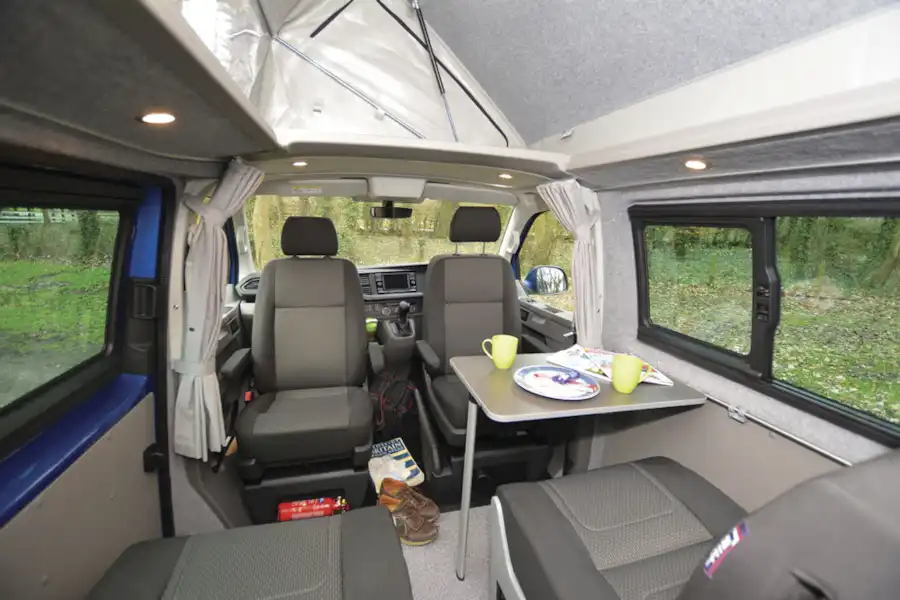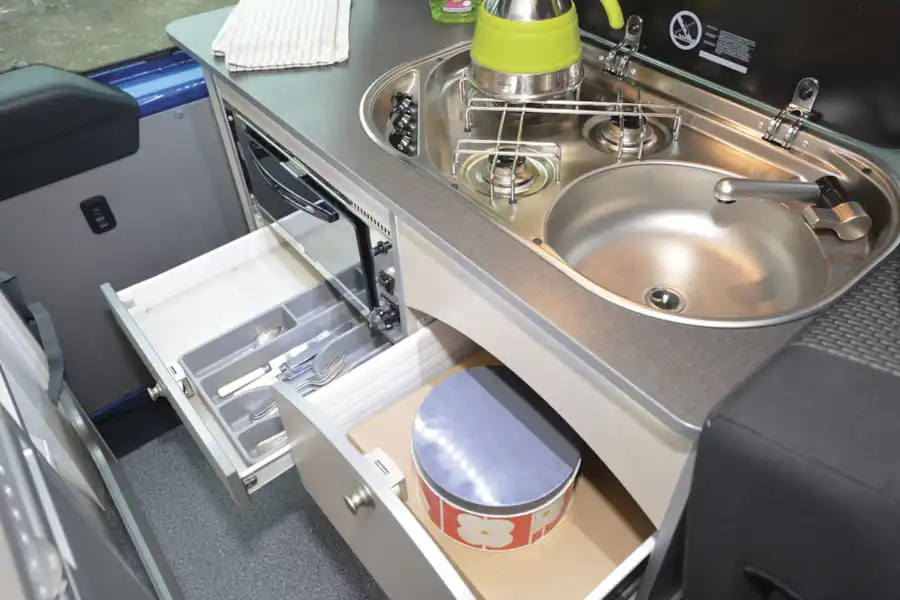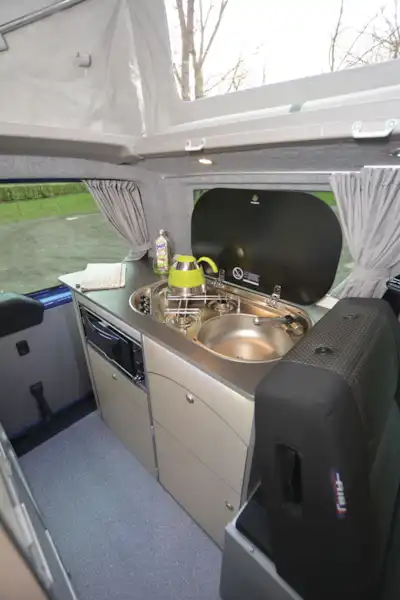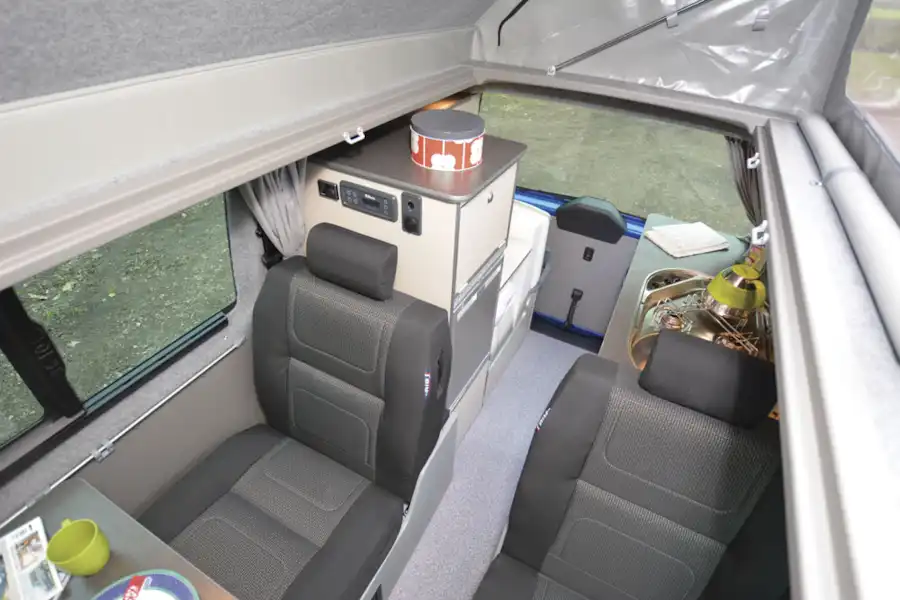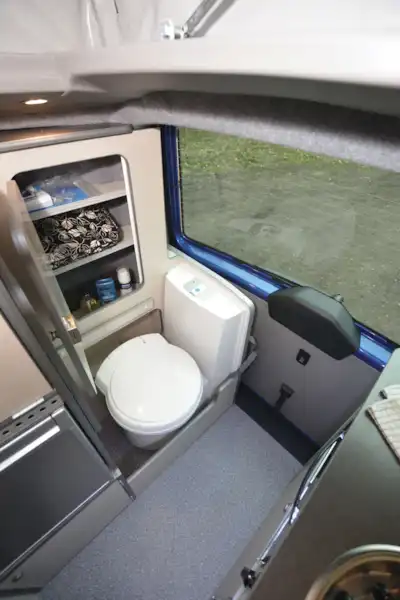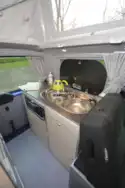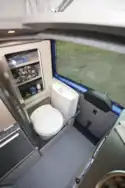Key Features
| Model Year | 2020 |
| Class | Rising Roof |
| Base Vehicle | Volkswagen T6.1 |
| Price From (£) | 50600 excl VED |
| Length (m) | 4.90 |
| Berths | 2 |
| Belted Seats | 4 |
| Main Layout | Front Lounge |
At a glance
Full review
Words by Peter Vaughan
See the latest Volkswagen Transporter from the rear and you’ll be convinced that nothing has changed. Even from the side it’s hard to spot what’s new, although you might notice a new ‘Transporter’ logo on the front wings neatly linking the headlights and indicator repeaters. In fact, the load area part of the van (the living space in a camper) hasn’t changed since the T5 debuted in 2003.
You can still see how closely related this recently launched T6.1 Transporter is to its predecessors, despite the bold (much deeper) new grille, slimmer headlights and horizontal chrome strips linking the two. It’s a bigger change visually than when the 2010-on ‘T5.5’ morphed into 2015’s T6 but, just as every generation of Golf seems to be a slight reworking of the last, the T6.1 is still very much the VW that fans know and love.
Bilbo's Nexa + HL campervan
It’s a similar situation at Bilbo’s, where designs are gradually improved rather than starting afresh. This latest Nexa+ actually debuted as a prototype at last October’s NEC show, but it can trace its development back to the Nektar model on the T4 (I tested one of the first for MMM way back in the January 1999 issue).
The Nektar became the Nexa when the T5 replaced the T4, while the Nexa+ is the latest chapter in the development of Bilbo’s rear kitchen layout as it answers customer requests for a fitted cassette toilet, rather than the Porta Potti in a cupboard of the standard model.
The bright Ravenna Blue of the test vehicle is, appropriately, one of four new metallic options for the T6.1. As the Nexa+ is based on a Highline-spec Transporter, it comes with 16in alloy wheels, automatic headlights, a heated windscreen, Bluetooth, a Category 1 alarm and automatic post-collision braking, plus new features of front and rear parking sensors, adaptive cruise control and electric/heated folding door mirrors.
Bilbo’s converts the Transporter in its Kombi form, rather than the panel van, so all of its windows are factory-fitted VW items and the rear seatbelt mountings are also in situ from Germany. The company says that Kombis are structurally stronger, thanks to reinforced floorplans, while the T30 designation means a 3,000kg gross weight (vans are also available in 2,600kg and 2,800kg versions with correspondingly reduced payloads).
The standard power unit for the Nexa+ is the new 108bhp (110PS) diesel (replacing the previous 101bhp/102PS model), which like all T6.1 engines is the latest (Euro 6d) development of the 2-litre TDI range.
Here, the motor had been upgraded to the desirable 148bhp (150PS) unit, which is where the DSG twin-clutch automatic (also fitted) first becomes available. Add both to your Bilbo’s and you’ll need to find an extra £4,400 but that’s money well spent in my book.
The Nexa + HL campervan on the road
It may boast the same output and capacity as its T6 forebear, but this new Transporter seems quieter on the road – it’s now a class leader for refinement. And everything that we always loved about the T5/T6 is still in place – the solid-feeling build quality being a particular highlight.
There’s a new dashboard design, too, that like everything else here shows Darwinian evolution. New storage areas feature and cup holders are now recessed into the top corners of the fascia, while the new leather-bound steering wheel has a flat bottom (as well as a plethora of radio/Bluetooth/cruise control switches).
Most noticeable, though, is the 6.5in colour touchscreen display in a section of the dash’ that’s angled gently towards the driver. Lower down there are two USB ports but the new infotainment system features App Connect to wirelessly link to Google Maps, Spotify, etc, from your iPhone.
The change that VW makes most fuss about is the switch from hydraulic to electromechanical power steering. This is claimed to reduce fuel consumption and, more significantly, allows the integration of driver assistance systems for the first time on a Transporter, including as standard Crosswind Assist (automatically activated above 50mph).
Also available at extra cost are Park Assist (which can park the T6.1 automatically in parallel or perpendicular spaces) and Trailer Assist (to help with the black art of reversing a trailer).
Needless to say, then, that the latest Transporter is the most eco-friendly and tech-laden yet, but what most customers will probably want to know is whether it still feels like a T6. To that we can answer a resounding ‘yes’. Some might still find the Transit Custom a more driver-centric vehicle but, as an all-round package (residual values included), the VW retains its crown. With ease.
While the majority of campervans in this class (including other models in the Bilbo’s stable) adopt the long-established side kitchen format, the Nexa+ appeals to buyers seeking either single beds or a fitted toilet, or both.
It’s based on a short-wheelbase Transporter (a long-wheelbase version is also offered), which at 4.90m long is shorter than a BMW 5 Series estate and fits into a typical parking bay – easily, thanks to excellent all-round vision, parking sensors front and rear and the optional camera.
Bilbo’s fits its own elevating roof, a proven design called the Low-Lie, which keeps overall height down to just over 2m when lowered. Unusually, in a market dominated by German Reimo and SCA pop-tops (and inferior copies), the Bilbo’s roof is side-hinged rather than lifting from the front or rear. That is more significant with this type of layout as it endows the whole living area with the same headroom – and at 2.14m maximum it’s plenty for even the tallest campervanners.
Raising the roof on Bilbo's Nexa+ HL campervan
Not only that, but the Low-Lie must be one of the easiest roofs to raise and lower. It is secured simply with two straps inside the campervan and, when raised, has two windows in the nearside to let lots of light into the vehicle. There are flyscreened panels (with covers) at either end for ventilation, while a 1.11m by 0.47m shelf at the front of the roof is very useful for coats and bags on site.
Below the roof, the layout is another established design, tweaked in this latest Nexa+ form to include a Thetford swivel cassette toilet. Up front, both cab seats swivel to face a pair of individual RIB chairs, while the main galley unit on the nearside is faced by more storage, the fridge and that all-important toilet.
The cab chairs and RIB seats match in VW’s new Titanium Black ‘Bricks’ cloth trim and the front seats come with twin armrests. They rotate easily on VW factory swivels, without opening the cab doors, to create a practical four-seat lounge with plenty of legroom for a quartet of campers, while the rear seats have a degree of backrest rake adjustment and come with automotive-type head restraints.
The kitchen in the Nexa+ HL campervan
As this is a two-berth conversion, there’s only a table on the offside. It stores (with leg folded underneath) between the toilet and the tailgate where it is easily accessible, although I did find it impossible to reattach its retaining strap with the rear door closed. The table is ideally sized for two diners and simply clips to a rail on the wall.
Many campervans of this size have just a two-burner hob, but the Nexa+ not only goes one better than that with an extra gas ring but it has a separate grill below, too. The hob is part of a Dometic combination sink and cooker with a one-piece glass lid, which has a surprisingly large worktop area to its left.
Below the sink is a large, deep drawer with an unusual arched front, while another much slimmer drawer under the grill serves for cutlery and utensils. Underneath here is a blank panel that hides the gas locker (accessed via the tailgate) and the fresh water tank (36 litres, inboard).
Then, forward of this is a large cupboard (tall enough for cereal packets, etc); it’s a shame that this isn’t another drawer, which would be easier to access in what remains a fairly confined space.
Bilbo’s has made good use of the rear end of this conversion, with a more generous amount of storage than you’d expect (or get in some rivals), although a gap of just 420mm between the opposing furniture units could be an issue for larger or less mobile customers.
It’s on the offside that the new Nexa+ differs from the original Nexa. The fridge (a 47-litre compressor model mounted off the floor for easier access) has moved forward to accommodate the cassette toilet in the rear corner, while there are useful cupboards both above and below the fridge.
Behind the toilet is a shallow wardrobe with hanging rail and also fitted with a couple of removable shelves. The toilet itself partially hides under a hinged flap that creates a little more working space for the cook but cannot act as a seat as it isn’t sufficiently well supported.
There’s plenty of room to sit but males may struggle to use the facilities standing up due to the intrusion of the section of original VW van roof above. Of course, the sink is close by for hand washing and an elasticated curtain simply clips in place between the kitchen and seating to provide some privacy from the front half of the camper (but only to roof-down height).
Of course, you’ll need to pull the kitchen and tailgate curtains, too, when using the toilet, and you’ll find lined curtains throughout the Nexa+, even around the cab where I’d opt instead for thermal screens.
The curtains provide good levels of blackout and they press-stud to the walls at appropriate intervals but, in the cab, they hang by your feet in bed, rather than forward, out of the way.
Sleeping in the Nexa+ HL campervan
The beds are simple to make – remove back seat headrests, fold rear seat squabs over through 180 degrees and tip backrests forward to horizontal – repeat on the other side and job’s done. One bed is just under 6ft long, the other is a shade over, and of course the centre aisle remains clear so either person can get up to go to the kitchen or loo without disturbing their partner (the tailgate is free for entry/exit of the camper, too).
Both beds are flat for three quarters of their length and slope down where your feet go on the cab chairs – it’s not a major comfort issue for most.
A Webasto programmable diesel-fired heater ensures that cold isn’t a problem, either. It’s a pricey option at £1,250 but one that you wouldn’t want to be without in our unpredictable climate. Its digital controller is mounted behind the offside rear passenger seat where you’ll also see the main Bilbo’s control panel, a 12V socket and twin USBs.
Opposite, on the end of the galley, is a double 230V power point. Lighting is generously catered for with a selection of LED downlights, over the kitchen, toilet, rear seats and even over the cab chairs. There’s also an LED strip running under the edge of the kitchen – a rare hint of bling from a maker that puts quality and practicality first.
And, on a practical note, the under-seat lockers are large and empty – you’ll be able to get all of your bedding into one of them.
Expert motorhome advice to your door!
Why not subscribe to one of our fabulous magazines and get expert advice, travel ideas, technical help and all the latest news for your motorhome and your motorhome adventures!
Want to know more about MMM magazine?
Every month MMM has articles written by motorhomers who have been there and done it, from great UK and European (and further afield) tours, campsite reviews, owners' reports and DIY projects among other things. MMM's tests, reviews and expert buying guides are not to be missed. MMM's technical advice is a must and includes everything from weekend jobs to longer-term DIY projects. And much more!
About MMM magazineWant to know more about What Motorhome magazine?
Every issue of What Motorhome magazine provides essential buying advice for anyone looking to buy a new motorhome or campervan or upgrade their existing model. With a pedigree of over 30 years of offering the best motorhome and campervan buying advice, every issue of What Motorhome includes more new motorhome and campervan reviews than you will find in any other magazine.
About What MotorhomeWant to know more about Campervan magazine?
Campervan is the exciting monthly magazine that will give you all the inspiration you need to explore the world in your campervan. Every issue is packed with real-life campervanning experiences, inspiring travel ideas in the UK and further afield, the best campsites to stay on, campervan road tests and reviews of the latest models, and much more!
About Campervan magazine

